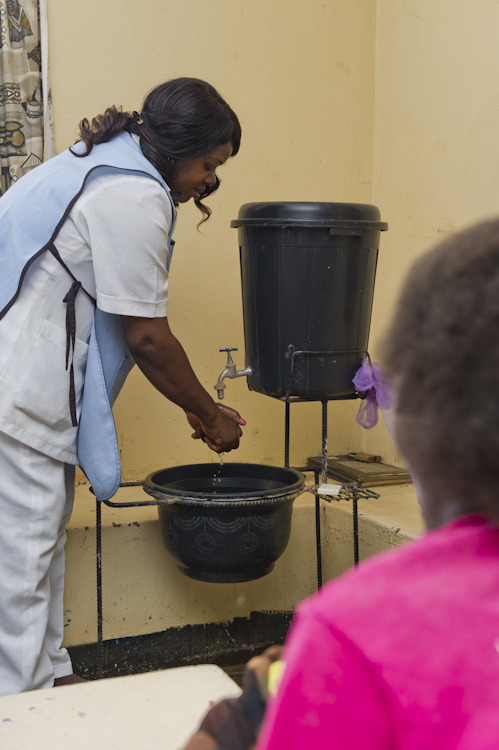
Improving hand hygiene for universal health coverage

In Zambia, a nurse washes her hands before showing a mother how to prepare oral rehydration solution. Photo: PATH/Gareth Bentley.
While the Global Handwashing Partnership is best known for Global Handwashing Day, there are so many occasions to celebrate and promote handwashing with soap. That’s why we are excited to celebrate our second favorite day of the year, World Hand Hygiene Day, on May 5. Here are some of the most common questions our team gets about Hand Hygiene Day and the larger issue of hand hygiene in health facilities.
What is Hand Hygiene Day?
The World Health Organization (WHO) established Hand Hygiene Day on May 5th to advocate for the importance of hand hygiene in healthcare settings through the Save Lives: Clean Your Hands campaign. Unlike Global Handwashing Day, which celebrates handwashing in all settings, Hand Hygiene Day focuses particularly on healthcare settings. This year’s theme, “Clean care for all – it’s in your hands,” emphasizes the importance of hand hygiene in achieving universal health coverage.
Clean hands are important for everyone – they can prevent harmful germs from entering our bodies and from passing them to other people. In
 My 5 Moments for Hand Hygiene. Source: World Health Organization.healthcare settings, proper hand hygiene is especially critical in preventing the spread of infections, keeping both health workers and patients safe.
My 5 Moments for Hand Hygiene. Source: World Health Organization.healthcare settings, proper hand hygiene is especially critical in preventing the spread of infections, keeping both health workers and patients safe.
Hand hygiene refers to the act of cleaning one’s hands with soap and water or with antiseptic handrub at the 5 moments for hand hygiene.These key times apply to all healthcare staff – including health workers, cleaners, and administrative staff. By health facilities, we mean anywhere health care is provided. These can range from hospitals to places like nursing homes, dialysis centers, and dental clinics.
What can be done?
Hand hygiene is a simple, yet often neglected act. The practice is well below where it needs to be, and Hand Hygiene Day is one of many efforts to improve hand hygiene. Currently, the WHO estimates that 70% of health workers do not routinely practice hand hygiene. The recent WHO/ UNICEF Joint Monitoring report on WASH in healthcare facilities showed that 1 in 6 health facilities globally has no hand hygiene facility at all, and 47% lack handwashing stations at points of care.
While infrastructure and knowledge about the practice of hand hygiene are key components of changing behaviors, these are insufficient on their own. Health facilities must also have the right accountability mechanisms, leadership, and policies in place to ensure health workers clean their hands. With these pieces working together, health facilities have seen (and will continue to see) dramatic improvements in hand hygiene practice, and with that, reductions in infection rates.
What do clean hands have to do with universal health coverage?
The ambition of universal health coverage (UHC) is for everyone to have access to appropriate health care. This means addressing not only financial risks for accessing care, but also ensuring that this care actually improves a person’s health. Clean hands are essential to quality patient care.
Imagine a mother takes her son to her local clinic because he has recurring diarrhea. Because the clinic lacks proper handwashing facilities or a sufficient supply of antiseptic handrub, the nurse does not wash his hands before examining the child. As a result, the nurse spreads harmful germs gathered from her previous patient onto the child. The nurse’s unclean hands caused the child to have a serious infection from his examination, and the mother is concerned that bringing the child back to the clinic will only make him sicker.
Now, imagine that same nurse has a convenient place to wash his hands between patients and that clinic leadership also prioritizes hand hygiene in its policies and has mechanisms to hold all staff accountable for cleaning their hands. In this scenario, the nurse pauses to clean his hands between patients, and then takes care of the child. No germs are spread from the nurse to other patients, and he prevents the infection from occurring.
Universal health coverage means health services are accessible, inclusive, safe, and clean. As part of this year’s Hand Hygiene Day campaign, the link between hand hygiene and UHC is clear. If we want to achieve ‘health for all,’ we must ensure ‘clean care for all.’
How can I get involved?
Hand Hygiene Day presents an opportunity for WASH and health advocates to work together to improve hand hygiene. Even if you’re new to the issue, here are a few things you can do:
- Join our Twitter storm on World Hand Hygiene Day on Sunday, May 5 at 10 am EDT by tweeting your example of how hand hygiene contributes to universal health coverage using #HHforUHC. Learn more here.
- Learn more about WASH in healthcare facilities. Find information and resources here.
- Advocate for the infrastructure, programs, and investments needed for better hand hygiene beyond World Hand Hygiene Day. Use our advocacy pack here.
Join us for Global Handwashing Day 2019
Global events, like World Hand Hygiene Day and Global Handwashing Day, present important opportunities for us to capitalize on the importance of good hand hygiene. This year’s Global Handwashing Day theme, “Clean hands for all,” complements the theme for World Hand Hygiene Day. While Hand Hygiene Day emphasizes the importance of hand hygiene in healthcare settings, it is also important to advocate for clean hands at all critical times. Join us in advocating for clean hands year-round and celebrate Global Handwashing Day with us on October 15!


